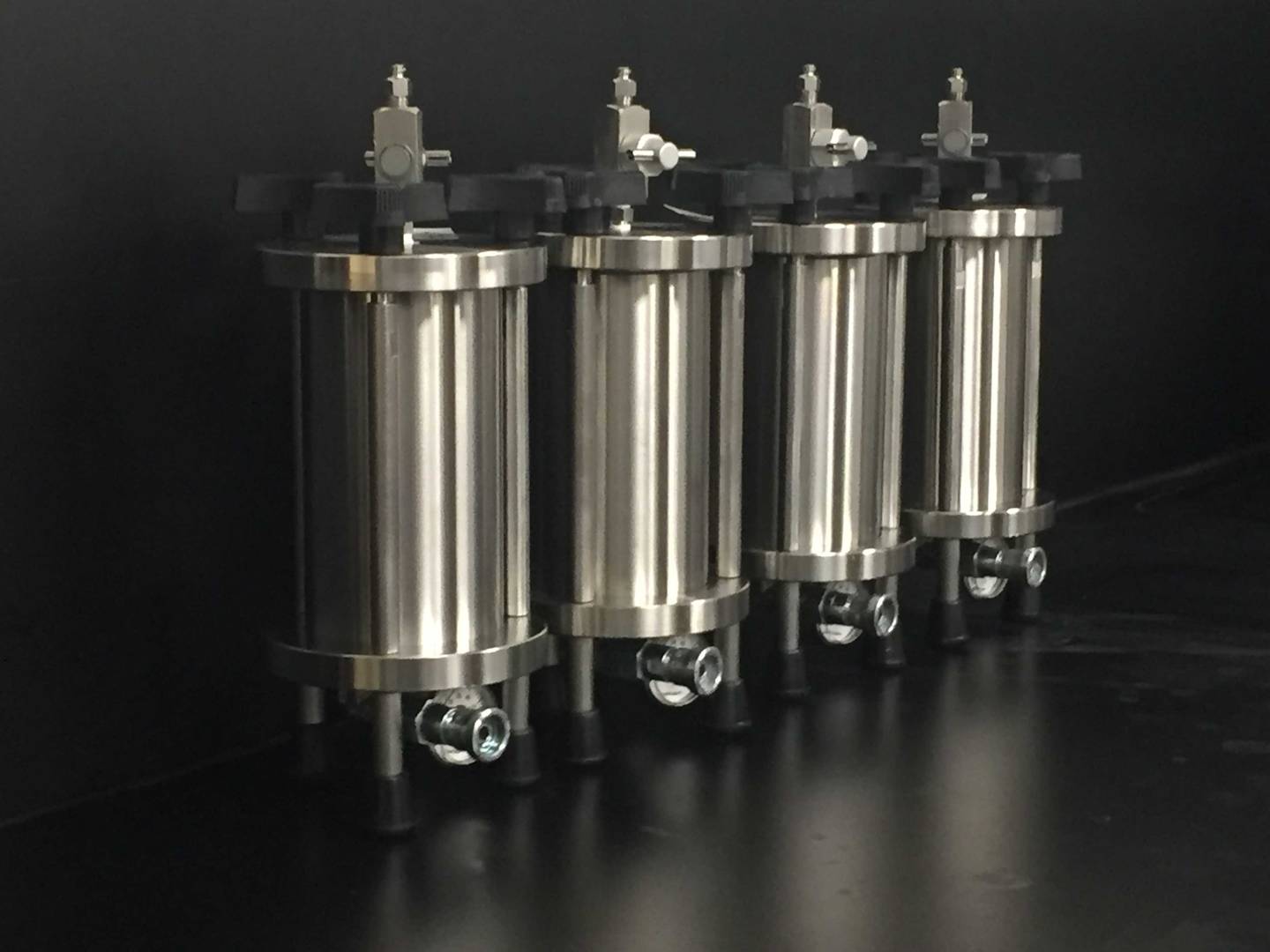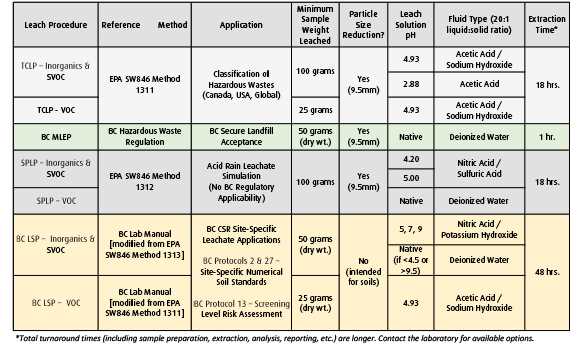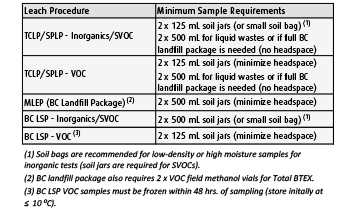EnviroMail 11 Canada
Applicability and Technical Differences of Leachate Test Methods in British Columbia
A leachate is a liquid (normally water) that, when contacting or passing through soil, waste, or other materials, will dissolve or incorporate soluble substances from those materials. In the context of environmental monitoring and waste management, leachate most commonly refers to drainage from a landfill or stockpile.

Laboratory leachate tests are conducted to simulate or characterize the soluble and mobile constituents of wastes, soils, or contaminated materials, to predict risks of migration and environmental groundwater or surface water contamination under different exposure scenarios. Several laboratory leachate tests are now commonly used in British Columbia, each designed for a very specific application.
Leachate method protocols that incorporate smaller particle size, stronger leach solutions and longer extraction times are considered more aggressive predictors of leachability. Acidic (low pH) leaching solutions generally increase the leachable concentrations of most metallic elements and many other inorganic substances, but pH has a lesser effect on most organic compounds.
Understanding the purpose and intent of available leachate tests is important, and helps practitioners to choose the most appropriate procedure when potential risks due to contaminant leaching must be assessed. Refer to the table that follows for a summary of characteristics and technical details of common leachate tests used in BC.
Toxicity Characteristic Leaching Procedure
TCLP (US EPA Method 1311) is used across Canada and the USA (and elsewhere globally) to classify wastes (solids, liquids, and liquid/solid mixtures) as hazardous or non-hazardous based on leachability and predicted mobility of organic and inorganic contaminants under acidic conditions. TCLP simulates the leaching of waste materials when codisposed with municipal solid waste in a landfill.
For metals, inorganics, and semi-volatile organic compounds (SVOCs), a preliminary pH measurement determines which of two acidic leaching solutions is used for an 18-hour chemical leach procedure. Samples with pH > 5 use a moderately strong acid leach fluid (pH 2.88). Samples with pH < 5 use a weakly acidic fluid (pH 4.93). If leachable volatile organic compounds (VOCs) are to be tested, a special zero-headspace extraction procedure is used to prevent loss of volatiles.
In BC, “leachable toxic waste” is defined as a waste whose TCLP leachate concentration exceeds any Leachate Quality Standards in Table 1, Schedule 4 of the BC Hazardous Waste Regulation (HWR). Note that if a total constituent analysis is carried out on the waste, and if the results indicate that the TCLP leachate concentrations could not possibly exceed the regulated limits (i.e. mathematically - based on the 20:1 liquid:solid ratio), then the leachate test is not required.
BC Modified Leachate Extraction Procedure
The BC MLEP is defined within the BC HWR, and has only one purpose – to determine whether a waste may be eligible for disposal at a secure BC landfill. For secure landfill disposal, the leachate concentrations of a waste must fall below the same Leachate Quality Standards that are used to classify hazardous wastes, but using the less aggressive MLEP test rather than the TCLP.
MLEP is similar to TCLP, but uses a shorter extraction time (1 hr. vs. 18 hrs.) with a less aggressive leaching solution (deionized water). A single leaching test is used for all organic and inorganic contaminants, including VOCs. MLEP is a less aggressive and less conservative test than TCLP because it is used only to identify hazardous wastes where the risk of storage at a secure landfill is unacceptable.
MLEP analyses are normally requested together with other tests required for landfill acceptance under a BC landfill analysis package (including flashpoint, paint filter test, total BTEX, TCLP BTEX, and pH).

Synthetic Precipitation Leaching Procedure
SPLP (US EPA Method 1312) has no current regulatory use in BC, and little regulatory use elsewhere in Canada (it is used on a limited basis for risk assessment purposes in Ontario). SPLP is a less aggressive leach test than TCLP, and predicts the leachability and mobility of organic and inorganic substances due to slightly acidic groundwater and surface water, mimicking leaching caused by acid rain. SPLP is similar in execution to TCLP, but uses only moderately acidic leaching solutions of pH 4.2 or 5.0, depending on whether soil samples originate from east or west of the Mississippi River (respectively). The more acidic pH 4.2 solution is used for eastern soils because acid rain impacts are more prevalent in eastern USA and southeastern Canada versus western regions. Wastes (non-soils) also use the pH 4.2 leach solution. As with TCLP, leachable VOCs are tested using a zero-headspace extraction procedure, but using deionized water as the leaching solution.
BC Liquid-Solid Partitioning Leaching Test
With the 2017 Stage 10 (Omnibus) updates to the Contaminated Sites Regulation (CSR), BC ENV approved a new leachate method to establish site specific numerical soil standards (Protocols 2 and 27), and for screening level risk assessments (Protocol 13). The BC LSP method was developed as a modification of US EPA Method 1313, and provides measurements of leachable organic and inorganic substances in soils under equilibrium conditions, at a minimum of three pH values (pH 5, 7, 9, and at the native soil pH if outside 4.5-9.5). The LSP for VOCs is closely modeled after the TCLP zero-headspace extraction procedure.
The LSP is more complex than simple leachate tests like TCLP, SPLP, or MLEP, because it is intended to predict worst-case equilibrium leachate concentrations across a range of pH values that could reasonably exist in groundwater at different sites and under different circumstances.

Sample Submissions
Refer to the table below for minimum sample submission requirements for each leachate test. Larger sample amounts are required for lowdensity samples (e.g. fly ash, cloth, fibrous material, wood waste), for very high moisture samples (e.g. peat/muskeg, sludge), and if other tests such as a full BC landfill package are required.
Working with an experienced laboratory is key to obtaining meaningful leachate test results in compliance with regulations. All leachate tests are empirical and prescriptive – they must be followed exactly to ensure accurate, reliable, and valid results that meet the intent of the test. Regulatory tests such as TCLP, MLEP, and BC LSP cannot be modified (e.g. shorter extraction times or smaller sample sizes) or the results may be deemed invalid for regulatory purposes.






















































